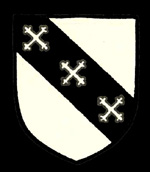The Manor of Beadlow
Volume II of The Victoria County History for Bedfordshire, published in 1908, gives the histories of all the manors in Clophill as far as they were known at the time. Beadlow Manor probably originated from land noted as being held by Azelina, wife of Ralph Taillebois in the Domesday Book of 1086. The overlord of the manor was the Barony of Cainhoe.
Between 1140 and 1146 the tenancy of this manor was given to the newly created Beadlow Priory, a cell of the Abbey of Saint Albans [Hertfordshire], by its founder Robert de Albini, Baron of Cainhoe. In 1428 Beaulieu Priory was closed by its mother house due to its poverty and Beadlow Manor thus became the property of Saint Albans Abbey until it too closed in 1539 as part if Henry VIII's dissolution of all the religious houses in England. Beadlow Manor thus became the property of the Crown.
In 1553 King Edward VI (1547-1553) gave Beadlow Manor to Sir William Fitzwilliam and his wife Joan. He died in 1558 and she died shortly afterwards, leaving the manor to be divided between their four daughters Mabel, wife of Thomas Browne, Katherine, wife of Christopher, Viscount Gormanston, Elizabeth, wife of Francis Jermye and another Elizabeth, wife of Innocent Rede. Mabel died in 1564 and was succeeded by her son Matthew who sold his share to Richard Charnock in 1585. This gave him the whole of the manor as he had already acquired the quarter shares of the other three Fitzwilliam girls.

The Charnock family coat of arms
The Charnock family held Beadlow manor until the mid 18th century. Sir Villiers Charnock held the manor in 1756 but by 1772 it was held, like Clophill and Cainhoe Manor and Clophill Hall Manor, by Amabel, Lady Grey. The manor remained in the possession of the heirs of Lady Amabel (Lord Lucas and Dingwall by the 20th century) until a succession of Law of Property Acts in the 1920s abolished manorial fines and incidents as well as copyhold land tenure, thus abolishing manors in practically all but name.